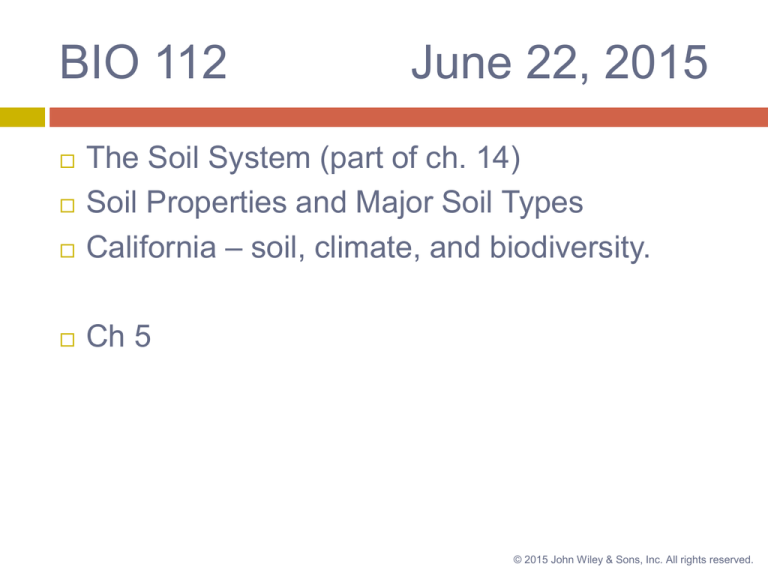
BIO 112
June 22, 2015
The Soil System (part of ch. 14)
Soil Properties and Major Soil Types
California – soil, climate, and biodiversity.
Ch 5
© 2015 John Wiley & Sons, Inc. All rights reserved.
14
Soil Resources
Soil
Uppermost layer of earth’s crust that supports
plants, animals and microbes
Soil Forming Factors
Weathering
of parent material
Time
Climate
Organisms
Topography
© 2015 John Wiley & Sons, Inc. All rights reserved.
Soil Composition - “typical soil”
Mineral Particles (45%)
Weathered
rock
Organic Material (5%)
Litter,
animal dung, dead remains of plants and
animals
Humus – black organic matter remaining after
most decomposition
Collective
name for many different organic compounds
Water (25%)
Air (25%)
© 2015 John Wiley & Sons, Inc. All rights reserved.
Soil Composition
Pore space
50%
of soil
Soil air - good
for aeration
Soil water provides water
to roots
© 2015 John Wiley & Sons, Inc. All rights reserved.
Soil Horizons
© 2015 John Wiley & Sons, Inc. All rights reserved.
Soil Organisms
© 2015 John Wiley & Sons, Inc. All rights reserved.
Soil Organisms
There are millions of microorganisms in 1 tsp of
fertile agricultural soil
Soil organisms provide ecosystem services
Def: Important environmental benefits that
ecosystems provide
Decaying and cycling organic material
Castings – from gut of earthworms
Breaking down toxic materials
Cleansing water
Soil aeration
Mycorrhizae
© 2015 John Wiley & Sons, Inc. All rights reserved.
Nutrient Cycling
The pathway of
various nutrient
minerals or elements
from the environment
through organisms
and back to the
environment
© 2015 John Wiley & Sons, Inc. All rights reserved.
Soil Properties
Soil Texture
Relative
proportion of sand, silt and clay
Sand: 2mm–0.05mm
Silt: 0.05mm–0.002mm
Clay: >0.002mm
© 2015 John Wiley & Sons, Inc. All rights reserved.
Soil Properties
Soil texture affects soil properties
Coarse textured soil (sandy)
Excellent
drainage
Fine textured soil (high in clay)
Poor
drainage
Low oxygen levels in soil
Due to negatively charged surface, able to hold
onto important plant nutrients (K+, Ca2+, NO2-)
© 2015 John Wiley & Sons, Inc. All rights reserved.
Soil Properties
Negative charge on clay attracts positivelycharged nutrients
© 2015 John Wiley & Sons, Inc. All rights reserved.
Soil Properties
© 2015 John Wiley & Sons, Inc. All rights reserved.
Soil Properties
Soil Acidity
Measured
using pH scale
pH of most soils range from 4–8
Affects solubility of certain plant nutrients
Optimum soil pH is 6–7, because nutrients are
most available to plants at this pH
Acid precipitation (primarily from industrial
emissions)
Sulfuric
and nitric acids
Alters soils, need to add calcium to reverse
© 2015 John Wiley & Sons, Inc. All rights reserved.
Major Soil Groups
Variations in soil forming factors cause
variation in soils around globe
Soil Taxonomy
Separates
soils into 12 orders in U.S.
Subdivided into more than 20,000 soil series that
vary by locality
Five common soil orders
Spodosols,
alfisols, mollisols, aridosols, oxisols
© 2015 John Wiley & Sons, Inc. All rights reserved.
Spodosols
Form under coniferous
forests
Cold, ample precipitation,
good drainage
O-horizon composed of
decaying needles
E-horizon is ash-gray
under thin A-horizon
Not good farmland- too
acidic
© 2015 John Wiley & Sons, Inc. All rights reserved.
Alfisols
Temperate deciduous
forests
Brown to gray-brown Ahorizon
Precipitation high
enough to leach most
organics and nutrients
out of O-, A- and Bhorizons
Soil fertility maintained
by leaf litter
© 2015 John Wiley & Sons, Inc. All rights reserved.
Mollisols
Found in temperate,
semi-arid grassland
Very fertile soil
Thick, dark brown/
black A-horizon
Soluble nutrients stay
in A-horizon due to
low leaching
Grow most grains
Deep rooting grasses
help form
© 2015 John Wiley & Sons, Inc. All rights reserved.
Aridisols
Found in arid
regions of all
continents
Low precipitation
preclude leaching
and growth of lush
vegetation
Development of salic
(salty) horizon
possible
© 2015 John Wiley & Sons, Inc. All rights reserved.
Oxisols
Found in tropical and
subtropical areas with
high precipitation
Very little organic
material accumulation
due to fast decay rate
B-horizon is highly
leached and nutrient
poor
© 2015 John Wiley & Sons, Inc. All rights reserved.



